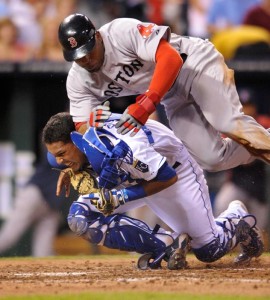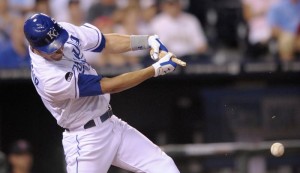Most of the time photographers tether their camera to the computer for instant feedback during a studio shoot. In my case, it was so I could deliver photos faster.I’ve connected my camera to the computer a few times over the years, usually so a client could see exactly what I’m shooting. That way they can give feedback about the shoot to make sure they’re getting exactly what they want. And each time I have an assignment, I try to find some new way approach it. That way it’s more interesting for me, and I have a chance to learn something new. So when the Associated Press asked me to shoot a recent baseball game, I thought, “What can I do different?” And in this case, because they always want images ASAP, I thought I’d try tethering.
As a Nikon shooter, I have two easy options for tethering. I can use Nikon’s

4th inning collision. Nikon D3, 4000 ISO, 400mm f/2.8 lens, f/2.8 at 1/1600 second. Photo copyright Reed Hoffmann.
Capture Control Pro software, which connects camera to computer and allows anything shot to be immediately written to the hard drive, or I can use Adobe Lightroom, which also supports that connection. In this case I went with Nikon’s software, as I wanted to use Photo Mechanic (www.camerabits.com) for browsing, metadata embedding, renaming and transmitting. While Lightroom can do most of that too, it’s slower. And I’d use Photo Mechanic’s “Live Ingest” feature, which watches a folder on the computer for new images and immediately brings them into an open contact sheet. The connection itself was done through a 5-meter USB 2.0 cable.
I couldn’t have been happier with the results. In the past at baseball I’d shoot, pull the card between innings, download, browse images, then try to quickly prep and transmit photos without missing too much of the game. Now, just a few seconds after shooting a picture, it would pop up on the Lenovo W510 laptop right behind me. Thanks to the long breaks between pitches, over the course of seven or eight throws I could turn around, pick a picture, edit it, caption and transmit, all in the same inning the play took place. It was great! Over the course of the nine innings, I transmitted 22 photos.

4th inning broken bat. Nikon D3, 2800 ISO, f/2.8 at 1/1600 with the 400mm 2.8 lens. Photo copyright Reed Hoffmann.
The only downside is that to stay tethered I had to stay in one place. If I decided to shoot an inning from the other side, or the concourse above, I’d need to disconnect, then come back and manually download. For this first time, though, I stayed tethered and in the dugout.
Next time I’m sure I’ll do it differently, maybe trying an Eye-Fi card to cut the cable and choose which images to send to the Lenovo. And that might let me move and shoot from other locations, all while still sending images to the laptop.
I admit, I get bored easily. That’s one reason I love photography, especially now that everything’s digital. You don’t have to shoot the

Last out of the game. Nikon D3, ISO 1400, f/2.8 at 1/1600 with the 400mm. 2.8 lens. Photo copyright Reed Hoffmann.
same way all the time. With a little imagination and the right tools, you can always be changing how you work. And more importantly, growing as a photographer.

